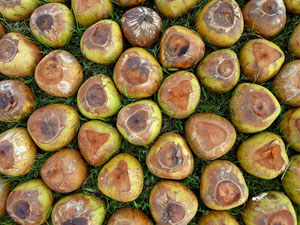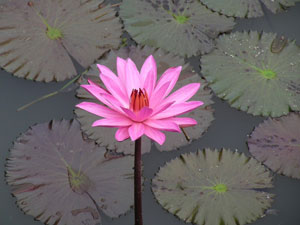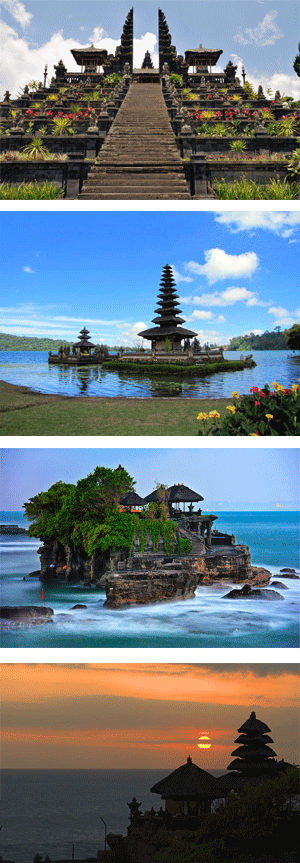
Bali, called the Island of the Gods is a little paradise right in the heart of the Indian Ocean. It is certainly the most famous and most popular of the 17.000 islands composing the Indonesian archipelago.
Its outstanding landscapes and the richness of its culture quickly led the island to be afavourite tourist destination in Asia. Balinese people have also managed to preserve their authenticity and culture, while taking advantage of the benefits that tourism could bring them.
Tourism has developed on Bali island in such a way that there is something for everyone. Whatever the type of holiday you are looking for, there is always a place in Bali to meet your expectations.
Besides many natural assets like heavenly beaches, the rice terraces, or the sumptuous seabed that makes Bali a paradise for divers, the island, thanks to its varied relief, offers countless activities for tourists such as surf, walking, rafting, photography… Also the richness of Balinese culture with its many rituals and ceremonies will seduce you and make your stay on Bali island something unforgettable.

Bali is located in the Indian Ocean,between Java and Lombok islands.
It is a volcanic island of 5637 km²,which is roughly equivalent to an area of 120 km on 80. Its population is approximately 3,3 millions inhabitants, 600.000 of which live in the capital, Denpasar. It represents a density of 585 inhabitants per km².
93% of the population is Hindu faith, this is why the island is full of Temples, most of them very impressive.
The island has several sea resorts, with beautiful white or volcanic sand beaches, most of them located along the south coast. The sea is often rough, offering some well known surf spots,but also many dive sites withseabed rich in fishes and corals.
Bali has a varied relief whose highest point is Mount Agung (3142 meters), and several mountain lakes, the most famous being Lake Batur.

The temperature varies throughout the year between 21 and 32°C with an average of 26°C. The temperature of the Indian Ocean itself remains quite stable, varying between 29 and 30°C.
Near the coast, temperatures range from 27 ° C (dry season) to 32 ° C (rainy season). In the mountains, it is around 20 to 25 ° C depending on altitude.
The rainy season begins in January and ends in March. During this period, rainfall is twice as important in the north of the island then in the south. The wettest month is usually January.
The dry season goes from May to December. However, a good shower remains possible during dry season, but usually don’t last and mainly happens in the afternoon. Daytime and night time are the same all over the year.

Bali is located only a few hundred kilometres south of the equator, which means that this island enjoys almost constantly the sun and nice temperatures, around 30°C on the coast and 22°C in the mountains.
The best time to travel to Bali ranges from May to September, during dry season, even if rains are still possible, specially in mountainous areas. These tropical storms can be very impressive, but they never last more than one hour and refresh the air.
But even if the dry season is undoubtedly the best time to go to Bali, it can be very nice to travel during the rainy season, provided that you organize yourself properly ( it is raining only in the late afternoon), and that you bear temperature variations since it can get very hot or rather cooler (do not forget to bring warm clothes).
In addition, during the rainy season, tourists are fewer and prices are lower than during the high season.

Bali lived mainly on the culture of rice until the middle of twentieth century. At this time the government encouraged the production diversification, export goods such as coffee, vanilla, tobacco or clove. The maritime resources have been little exploited and fishing remainsreserved for poor people. The island has not experienced any real industrialization except in the South where there are few small businesses of textile and furniture. Craft is also an important and dynamic activity, intended primarily for Tourists and export. But for the last thirty years, tourism has been representing the main part of Balinese economy with about two thirds of the island resources.

Change money.
In tourist places, you will find plenty of exchange offices. No problem then for changingEuros in Rupees.
Prefer officials offices (Money centers) with a rate “no commission” (commission free), as commission is already included in the exchange rate. Other offices offer more attractive rates, but without indicating their commissions. you will avoid surprises and tedious calculations choosing money centers.
Change your money during week days (rates are often less interesting on the weekend), and in tourist areas (the competition is tougher). Take your time and compare the rate of 2 or 3 offices before changing your money.
If nevertheless you choose unofficial offices, (easily identifiable at the rate displayed is much more interesting), do the calculation of the amount you should receive with calculator, and re-count always money that you are given in front of the agent, keeping the money in your hand, even if he urges you.

In tourist places you will find as well many ATM. They keep you from having to carry with you too much cash. Depending on the bank, it is possible to withdraw up to two million rupees (about 175 €). On each transaction a commission will be charged (call your bank before departure to know how much it is)

In Bali, it is a way of life and the prices announced by the shopkeepers are always subject to negotiation and can easily be divided by 2 or 3 with some glibness.
Do not show too much interest, and do not hesitate to leave if the price does not suit you. The seller will probably propose a better price.
It is very appreciated to leave an additional note upon payment of a negotiated item. There are great chances that the seller uses the note to bless his wares

Days in Bali are punctuated by prayers, donations and religious ceremonies. Although Indonesia is the largest Muslim country in the world, Balinese people are mostly of Hindu faith (93%)
The Hinduism from India is a polytheistic religion, so Balinese people worship plenty of gods. One of the fundamental aspects of this religion is the belief in reincarnation and karma. The Balinese believe that every action in the present determines their future existence.
It is unclear how Hinduism has emerged in Bali, but the most plausible hypothesis is that monks came fromIndia to develop Hindu faith in Bali. Over time, Balinese Hinduism differed from the Indian one, and a peculiar form of Hinduism emerged in Bali.
This form of Hinduism called “Agama Tirtal” which literally translated means science of holy water. Like Hinduism in India, the Agama Tirtal uses the notion of caste, but to a much lesser extent. This is why the Balinese live in a mutual respect, whatever their caste. The difference between the two forms of Hinduism is also that Agama tirtal is animist and more close to the earth than Hinduism from India. In addition, the Balinese are very afraid of evil spirits which can take different forms and live in the sea.
The temples
They represent the link between Balinese and their Gods, each house having its own temple, which size is depending on the owner’s wealth. To those are added the main temples where ceremonies take place. The most important ones are in Besakih, Uluwatu and Tanah Lot.
It is often said that the island of Bali has more temples than people !
Religion takes a very important place in the life of the Balinese. That’s where they spend much of their time and money. Every day many ceremonies take place on the island of the gods. One can see a multitude of altar splaced near a tree, a river or at a crossroads, to calm down the evil spirits.
There is no day on the island of the gods without a festival or a ceremony. The richness of Balinese culture is a key strength of the island.
The Balinese are extremely believer, most of the rites and ceremonies are directly related to religion even if some of these customs turned into real tourist attractions (includingtraditional dances). Others are quite genuine. The Balinese are very open-minded andtolerant, the ceremonies are open to the public and tourists are well accepted.
Given the omnipresence of religion, you will come without doubt through one of the various ceremonies and traditional festivals taking place everyday on the island of Bali.